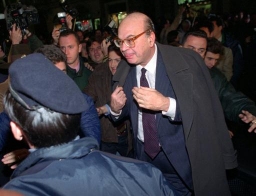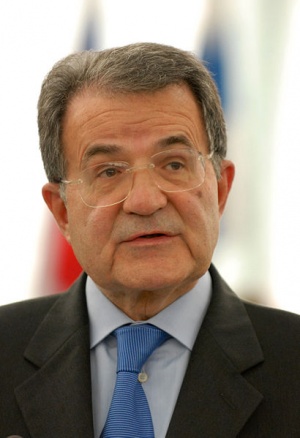Politics
The Politics of Italy takes place in a framework of a parliamentary representative democratic republic, whereby the Prime Minister of Italy is the head of government, and of a pluriform multi-party system. Executive power is exercised by the government. Legislative power is vested in both the government and the two chambers of parliament. The Judiciary is independent of the executive and the legislature. Italy has been a democratic republic since June 2, 1946, when the monarchy was abolished by popular referendum (see birth of the Italian Republic). The constitution was promulgated on January 1, 1948.
Government
The 1948 Constitution of Italy established a bicameral legislature (parliament), an executive branch composed of a Council of Ministers (cabinet), headed by the President of the Council (prime minister), and a separate judiciary branch. The government depends on confidence from each branch of the parliament, and has in turn the power to make decrees. Decrees have to be confirmed in the parliament, and "decree jam" has been a problem in recent years, as governments try to reform the structure of the state using chiefly decrees instead of passing laws directly through the parliament.
- Main article: President of the Italian Republic

As the head of state, the President of the represents the unity of the nation and has many of the duties previously given to the king of Italy. The president serves as a sort of point of connection between the three branches of power: he is elected by the lawmakers, he appoints the executive, and is the president of the judiciary. The president is also the commander in chief of armed forces.
The President of the Republic is elected by an electoral college consisting of both houses of Parliament and 58 regional representatives for a seven-year term. Its election needs a wide majority that is progressively reduced from two-thirds to one-half plus one of the votes as the ballots progress. The only Presidents ever to be elected on the first ballot are Francesco Cossiga and Carlo Azeglio Ciampi. Mr. Ciampi was recently replaced by Giorgio Napolitano, who was elected on 10 May 2006. While it is not forbidden by law, no president has ever served two terms.
Usually, the President tries to stay out of the political debate, and to be an institutional guarantee for all those involved in the political process. The president can also reject openly anti-constitutional laws by refusing to sign them, since he acts as the guardian of the Constitution of Italy.
- Main article: President of the Council of Ministers of Italy
The President of the Republic appoints the President of the Council of Ministers (the prime minister), who then proposes (the President actually submits them) the individual ministers of the respective minstries who together form the Council of Ministers (the cabinet), which in turn must receive a vote of confidence from both parliamentary chambers. The prime minister, through the cabinet, effectively runs the government of Italy. The current Prime minister is Romano Prodi.
Legislative branch
- Main article: Parliament of Italy
Italy elects, on the national level, a Parliament consisting of two houses, the Chamber of Deputies (Camera dei Deputati) (630 members) and the Senate of the Republic (Senato della Repubblica) (315 elected members, plus a few senators for life). As of 15 May 2006, there are seven life senators (of which three are former Presidents). Both houses are elected for a maximum of five years, but both may be dissolved before the expiration of their normal term. Legislative bills may originate in either house and must be passed by a majority in both.
Judicial branch
- Main article: Judiciary of Italy
The Italian judicial system is based on Roman law modified by the Napoleonic code and later statutes. It is based on an inquisitorial civil law system. Appeals are treated almost as new trials, and three degrees of trial are present.
There is only partial judicial review of legislation in the American sense. Judicial review exists under certain conditions in the Constitutional Court, which can reject anti-constitutional laws after scrutiny.
The Constitutional Court is composed of 15 judges one of which is the President of the Italian Constitutional Court elected from the court itself. One third of the judges are appointed by the President of the Italian Republic, one-third are elected by Parliament and one-third are elected by the ordinary and administrative supreme courts. The constitutional court, or Corte Costituzionale, passes on the constitutionality of laws, and is a post-World War II innovation. Its powers, volume, and frequency of decisions are not as extensive as those of the U.S. Supreme Court.
Italy has not accepted compulsory jurisdiction of the International Court of Justice.
Political parties and elections
Template:Elect All Italian citizens older than 18 can vote. However, to vote for the senate, the voter must be at least 25 or older. Template:Italian general election, 2006-Deputies Template:Italian general election, 2006-Senate
Political parties
Italy's dramatic self-renewal transformed the political landscape between 1992 and 1997. Scandal investigations touched thousands of politicians, administrators, and businessmen; the shift from a proportional to an Additional Member System (with the requirement to obtain a minimum of 4% of the national vote to obtain representation) also altered the political landscape.
Party changes were sweeping. The Christian Democratic party dissolved; the Italian People's Party and the Christian Democratic Center emerged. Other major parties, such as the Socialists, saw support plummet. A new liberal movement, Forza Italia, gained wide support among moderate voters. The Alleanza Nazionale (National Alliance) broke from the (alleged neo-fascist) Italian Social Movement (MSI). A trend toward two large coalitions (one on the center-left and the other on the center-right) emerged from the April 1995 regional elections. For the 1996 national elections, the center-left parties created the Olive Tree coalition while the center-right united again under the House of Freedoms. These coalitions continued into the 2001 and 2006 national elections.
This emerging bipolarity represents a major break from the fragmented, multi-party political landscape of the postwar era, although it appears to have reached a plateau, since efforts via referendums to further curtail the influence of small parties were defeated in 1999 and 2000.
History of the post-war political landscape
First Republic
There have been frequent government turnovers since 1945, indeed there have been 61 governments in this time [1]. The dominance of the Christian Democratic party during much of the postwar period lent continuity and comparative stability to Italy's political situation, mainly dominated by the attempt of keeping the Italian Communist Party (PCI) out of power, to maintain Cold War equilibrium in the region.
The communists were in the government only in the national unity governments before 1948, in which their party's secretary Palmiro Togliatti was minister of Justice. After the first democratic elections with universal suffrage in 1948, in which the Christian Democracy and their allies won against the Popular front of the Italian Communist and Socialists parties, the communist party never returned in the government.
Even though many repeat the cliché that Italy had over fifty governments in its first fifty years of democracy to stigmatise its alleged political instability, Italy's main political problem was actually the opposite: in all the course of the so-called First Republic, the government was in the hands of the Christian Democrats and their allies, since it was unacceptable for a communist party to rule a western country during the Cold war. The system had been nicknamed the imperfect bipolarism, referring to more proper bipolarism in other western countries (the United States, Germany, the United Kingdom, France etc.) where right-wing and left-wing parties alternated in government.
The Socialists enter the Government
The main event in the First Republic in the sixties was the inclusion of the Socialist party in the government, after the reducing edge of the Christian Democracy (DC) had forced them to accept this alliance; attempts to incorporate the fascist Italian Social Movement (MSI) in the Tambroni government led to riots, and were short-lived.
Aldo Moro, a relatively left-leaning Christian democrat, inspired this alliance. He would later try to include the Communist Party as well, with a deal called the historical compromise. This attempt at compromise was, however, stopped by the kidnapping and murder of Moro in 1978 by the Red Brigades, an extremist left-wing terrorist organisation. Extreme-left apologists have created elaborate conspiracy theories in order to suggest that the actual organizers of the kidnapping were members of The Christian Democrats and the mafia, but no evidence exists to support these theories.
The Communist party was at this point the largest communist party in western Europe, and remained such for the rest of its existence. Their ability to attract members was largely due to their pragmatic stance, especially their rejection of extremism, and to their growing independence from Moscow (see eurocommunism). The Italian communist party was especially strong in areas like Emilia Romagna, where communists had been elected to stable government positions. This practical political experience may have contributed to their taking a more pragmatic approach to politics.
The Lead Years
- See also: Strategy of tension
The lead years (anni di piombo) spans from the December 1969 Piazza Fontana bombing to at least the 1980 Bologna bombing.
On December 12, 1969, a roughly decade-long period of extremist left- and right-wing political terrorism, known as the lead years (Italian: anni di piombo), began with the Piazza Fontana bombing in the center of Milan, which neofascist Vincenzo Vinciguerra later declared to be an attempt to push the Italian state to declare a state of emergency, in order to lead to a more authoritative state. A bomb left in a bank killed about twenty, and was initially blamed on anarchist Giuseppe Pinelli. This accusation was hotly contested by left-wing circles, especially the Maoist Student Movement, very strong in those years in Milan's universities, who considered the bombing to have all the marks of a fascist operation; their guess was proved correct, but only after many years of difficult investigations.
The strategy of tension attempted to blame the left for bombings carried out by right-wing terrorists. Fascist "black terrorists," such as Ordine Nuovo or Avanguardia Nazionale, were, in the 1980s-90s, found to be responsible for several terrorist attacks. On the other extreme of the political spectrum, the leftist Red Brigades carried out assassinations against specific persons, but weren't responsible for any blind bombings. The Red Brigades killed socialist journalist Walter Tobagi, and, in their most famous operation, kidnapped and assassinated Aldo Moro, president of the Christian Democracy, who was trying to involve the Communist Party in the government through the compromesso storico ("historic compromise"), to which the radical left, as well as Washington, were opposed. It is worth noting that the Red Brigades met fierce resistance from the Communist Party and the trade unions; some left-wing politicians, however, used the sympathetic expression "comrades who are mistaken" (Italian: Compagni che sbagliano) to refer to the Red Brigades. Radical left apologists have alleged that the Red Brigades (or at least the 2nd Red Brigades, led by Mario Moretti) were exploited by right-wing or possibly foreign forces to destabilize Italy, discredit the Communist Party and impede the historic compromise. This is a hotly contested claim which many consider to have the hallmarks of a blame-the-victim conspiracy theory, that the evidence does not support.
The last and largest of the bombings, known as the Bologna massacre, destroyed the city's railway station in 1980. This was found to be a neofascist bombing, in which Propaganda Due was involved.
On October 24, 1990, Prime minister Giulio Andreotti (DC) revealed to the Parliament the existence of Gladio, NATO's secret "stay-behind" networks which stocked weapons in order to facilitate an armed resistance in case of a communist coup. In 2000, a Parliament Commission report from the Olive Tree (left-wing) coalition concluded that the strategy of tension followed by Gladio had been supported by the United States to "stop the PCI and, to a certain degree, the PSI [Italian Socialist Party] from reaching executive power in the country."
The Eighties
With the end of the lead years, the communist party gradually increased their votes under the leadership of Enrico Berlinguer. The Socialist party, led by Bettino Craxi, became more and more critical of the communists and of the Soviet Union; Craxi himself pushed in favor of Ronald Reagan's positioning of Pershing missiles in Italy, a move many communists strongly disapproved of.
As the socialist party moved to more moderate positions, it attracted many reformists, some of whom were irritated by the failure of the communists to modernize. Increasingly, many on the left began to see the communists as old and out of fashion, while Craxi and the socialists seemed to represent a new liberal-socialism. The Communist party surpassed the Christian Democrats only in the European elections of 1984, held barely two days after Berlinguer's death, a passing that likely drew sympathy from many voters. The election of 1984, however, was to be the only time the Christian Democrats did not emerge as the largest party in a nation-wide election in which they participated.
In 1987, one year after the Chernobyl accident following a referendum in that year, a nuclear phase-out was commenced. Italy's four nuclear power plants were closed down, the last in 1990. A moratorium on the construction of new plants, originally in effect from 1987 until 1993, has since been extended indefinitely.[1]
In these years, corruption began to be more extensive, a development that would be exposed in the early nineties and nicknamed Tangentopoli. With the Mani Pulite investigation, starting just one year after the collapse of the Soviet Union, the whole power structure faltered, and seemingly indestructible parties, such as the Christian Democrats and the Socialist party, disbanded; the communist party changed its name to the Democratic Party of the Left and took the role of the socialist party as the main social democratic party in Italy. What was to follow was then called the transition to the Second Republic.
Second Republic



From 1992 to 1997, Italy faced significant challenges, as voters, disenchanted with past political paralysis, massive government debt, extensive corruption, and organized crime's considerable influence--collectively called Tangentopoli after being uncovered by Mani pulite)--demanded political, economic, and ethical reforms.
In the Italian referendums of 1993, voters approved substantial changes, including moving from a proportional to an Additional Member System, which is largely dominated by a majoritarian electoral system and the abolition of some ministries, some of which, however, have been reintroduced with only partly modified names, such as the Ministry of Agriculture reincarnated as the Ministry of Agricultural Resources).
Major political parties, beset by scandal and loss of voter confidence, underwent far-reaching changes. New political forces and new alignments of power emerged in the March 1994 national elections. This election saw a major turnover in the new parliament, with 452 out of 630 deputies and 213 out of 315 senators elected for the first time.
The 1994 elections also swept media magnate Silvio Berlusconi (leader of "House of Freedoms" coalition) into office as Prime Minister. Berlusconi, however, was forced to step down in December 1994 when the Lega Nord withdrew support. The Berlusconi government was succeeded by a technical government headed by Prime Minister Lamberto Dini, which left office in early 1996.
A series of center-left coalitions dominated Italy's political landscape between 1996 and 2001. In April 1996, national elections led to the victory of a center-left coalition, the Olive Tree, under the leadership of Romano Prodi. Prodi's government became the third-longest to stay in power before he narrowly lost a vote of confidence, by three votes, in October 1998.
In May 1999, the Parliament selected Carlo Azeglio Ciampi as the President of the Republic. Ciampi, a former Prime Minister and Minister of the Treasury and, before entering the government, the governor of the Bank of Italy, was elected on the first ballot by a comfortable margin over the required two-thirds of the votes.
A new government was formed by the Democrats of the Left leader and former communist Massimo D'Alema, but in April 2000, following poor performance by his coalition in regional elections, D'Alema resigned.
The succeeding center-left government, including most of the same parties, was headed by Giuliano Amato, a social-democrat, who had previously served as Prime Minister in 1992-93, and had at the time sworn never to return to active politics.
National elections held on May 13, 2001 returned Berlusconi to power at the head of the five-party center-right "Freedom House" coalition, comprising the prime minister's own party, Forza Italia, the National Alliance, the Northern League, the Christian Democratic Center, and the Democrats' Center Union. Between May 17, 2006 and Feb 21 2007, Romano Prodi served as Prime Minister of Italy following the narrow victory of his l'Unione coalition over the Casa delle Libertà led by Silvio Berlusconi in the April 2006 Italian elections. Following a government crisis, Prodi submitted his resignation on February 21, 2007. Three days later he was asked by the Italian President, Giorgio Napolitano to stay on as Prime Minister and he agreed to do so. On 28 February 2007, Prodi narrowly survived a senate no confidence vote. [2]
In general there is wide consesus on the fact that italian politics has been undergoing a slow involution over at least the last decade. This has been sometimes cited, even by some italian politicians, as a cause of the general feeling of lack of representation Italians recently seem to suffer from. Corruption is still widespread and the italian administration is often rightly percieved as inefficient and expensive, with even technical positions assigned for political reasons (at best). As a matter of fact an enormous amount of unjustified privileges are presently connected to political and administrative positions, regardless of skill, integrity and efficiency of the holder.
Administrative division
- Main article: Regions of Italy
The Italian State has twenty regions and about a hundred provinces. The constitution of Italy provides for twenty regions with extended powers. Regions are further divided in provinces. Provinces also have their own local elections. For each of the provinces, a prefect is appointed by and responds to the central government, which he locally represents. While the number of regions is somewhat stable (the only modification to the original set is the separation of Molise from Abruzzo), there has been a tendency in later years to create new provinces, such as Crotone, Verbania, Lodi, Biella, Lecco and others.
Five regions (Aosta Valley, Friuli-Venezia Giulia, Sardinia, Sicily, Trentino-Alto Adige/Südtirol) have special charters granting them varying degrees of autonomy. The raisons d'être of these charters is in most cases the presence of significant linguistic and cultural minorities, but in the case of Sicily it was to calm down separatist movements. The other 15 regions were in practice established in 1970, even if their ideation had been a much earlier idea. They vote for regional councils.
See also
- Foreign relations of Italy
- List of political parties in Italy
- History of Italy as a Republic
- Corruption Perceptions Index
- ↑ "Pasta and fries".The Economist (February 24th -March 2nd 2007 Issue) Volume 382, Number 8517
- ↑ BBC News: Italian Prime Minister survives senate vote


